Fire sprinkler systems are one of the most effective forms of fire protection. In order for a sprinkler system to protect a facility from a fire, it must be designed well. Fire sprinkler system design should be performed by highly skilled and licensed sprinkler designer.
Regulations for Sprinkler Design
Typically, fire sprinkler systems are designed in accordance with NFPA 13, the Standard for the Installation of Sprinkler Systems. On top of NFPA 13, some AHJs (Authority Having Jurisdiction) have additional regulations when it comes to fire sprinkler design.
What needs to be taken into consideration when designing sprinkler systems?
Designing a fire sprinkler system is a complex process. There are many elements that must be taken into consideration when designing a sprinkler system. Some things to consider include:
- Water supply – It is important to have sufficient water supply in order to control a fire. When designing a sprinkler system, the water supply must be identified and a flow test should be performed. The sprinkler designer can then perform hydraulic calculations to determine which pipes and sprinklers are needed and if a fire pump must be installed.
- Type of sprinkler system needed – Designers must utilize architectural and engineering plans to determine the type of building and decide whether the building needs a wet pipe, dry pipe or pre-action sprinkler system.
- Hazard level of the building – An important step in the sprinkler design process is understanding the occupancy hazard. The occupancy hazard classifications are:
- Light Hazard
- Ordinary Hazard (Group 1)
- Ordinary Hazard (Group 2)
- Extra Hazard (Group 1)
- Extra Hazard (Group 2)
- Special occupancy hazard (including storage)
The hazard classification is used to estimate the fuel load and the water demands for the area being protected.
- Choosing sprinkler heads – When designing a sprinkler system, it is important that each sprinkler covers the correct amount of space. Designers must calculate how far apart each sprinkler head must be and how much flow a sprinkler head can deliver.
- Sprinkler pipe selection – Designers must determine the size, material and location of sprinkler pipes. The pipe material and the size of the pipes can affect the water pressure, cost and corrosion resistance.
Designing a fire sprinkler system can be a complicated process. If you have questions about the sprinkler design process, reach out to a qualified fire protection professional.
Work with Beach Lake Sprinkler for Fire Protection Design
At Beach Lake Sprinkler, we design fire sprinkler systems for commercial, industrial, and residential applications. We work with you to design a fire sprinkler system that will adequately protect your facility and comply with NFPA 13 as well as local code. We utilize the latest technologies when designing sprinkler systems including BIM and CAD. Our NICET Certified Engineer Technicians will create complete fire protection drawings and perform the necessary hydraulic calculations to give your building optimal protection. If you are interested in learning more about fire sprinkler design, contact us today.
